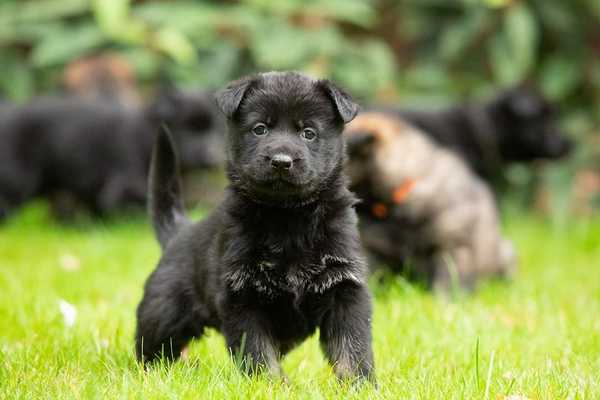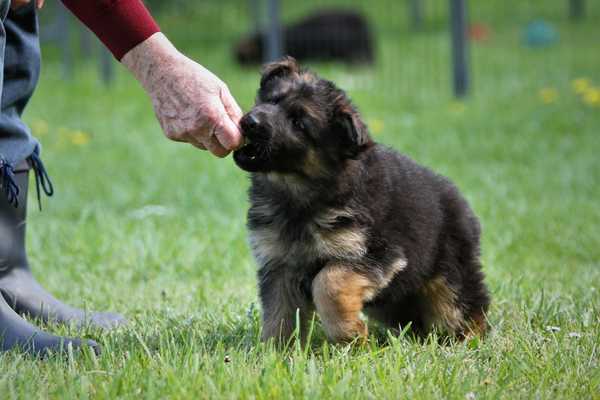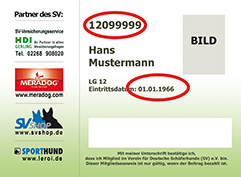Collar and leash
Wearing a collar and leash is an unusual and initially very uncomfortable restriction for your puppy. But once it moves in with its new family, both objects will be its loyal companions whenever it leaves the house. In order not to make the new situation even more uncomfortable for your dog, make sure when you buy it that the collar is as wide and adjustable as possible. Then it will be less likely to choke the puppy when it pulls vigorously. You have a choice of three models for the leash: lead, drag leash and flexi leashes. While drag leashes (from 6 m in length) are particularly suitable for training, adjustable-length leads (up to 2 m) and auto-retractable flexi leashes (up to 8 m) are more suitable for everyday use. Puppy owners are advised not to use flexi leashes, as they are only suitable for well-behaved animals. Your choice of material depends on your taste: leather, plastic, nylon? An important rule of thumb is: the smaller the dog, the lighter the leash!
Chip
Chip identification can be carried out from the age of 50 days, but in any case, before the puppy is given to the new owner, either by a veterinarian or by an ID representative from Verein für Deutsche Schäferhunde (SV) e.V. a biopolymer the size of a grain of rice is injected under the skin. Each chip has a number that is stored along with the owner’s contact information. If your puppy runs off, the number can be read with a chip reader. The chip lasts a lifetime.
Finding a veterinarian
You should start looking for a vet when the puppy moves in, at the latest. The breeder will usually be able to give you an address. If not, ask other dog owners for recommendations and their experience. Tip for finding a vet: make sure that the practice is not too far from your home; after all, every minute counts in an emergency.
Collecting the puppy
Before taking the puppy home, you should visit it several times beforehand so that you are already somewhat familiar with each other. This will help the little puppy when you collect it and introduce it to a new environment. The breeder will be happy to arrange an appointment for you. It is best to schedule it for a holiday or a Friday or Saturday so that you have plenty of time for the puppy in the first few days and can help it get used to its new home.
Accessories
Before you collect the puppy, you should get a basic set of accessories. These include: a collar, a harness, a dog basket and food – preferably the same food that the puppy has already been getting from the breeder. A dog brush should be acquired, too, since grooming is very important from day one. The collar, made of a material such as leather or nylon, should be reliable and good quality.
Dog bed
Before the puppy arrives, you should think carefully about where its bed will be. Make sure that the bed is always a suitable retreat for your dog. But also make sure that your dog isn’t completely isolated from what is going on in the house. The appearance of the bed is up to you. For example, you can build your dog a bed out of a thin, not-too-soft mattress or an old blanket.
Food and eating area
Most breeders give puppy buyers a feeding plan and a small supply of the food the puppy has been eating up till now. This can help prevent digestive issues caused by an abrupt change of diet. Get the puppy used to a fixed eating area from the first day, and always give it its food in its bowl. In addition to food, the puppy should always have access to fresh water. Non-slip stainless steel bowls prevent the puppy from knocking over its food.
Toys
You should have appropriate toys available as soon as the puppy moves in. In this case, appropriate means: light enough so that the puppy can carry it and large enough not to be swallowed. Your puppy will be delighted with a ball or a knotted piece of rope. However, you can safely assume that it will also claim certain household items (such as socks) as toys. It is important never to leave the puppy unattended with a toy. After playing with the toy and people, the toy needs to be removed.
Upbringing and training
EAGER TO LEARN · SOCIAL · OBEDIENT
Happy to help: the German Shepherd is a reliable partner in every situation – for a lifetime. In order for the little puppy to become a family-friendly, confident and well-balanced dog, loving but consistent upbringing is the be-all and end-all. As such, our SV Local Groups offer you support in the upbringing and training of your four-legged friend.








